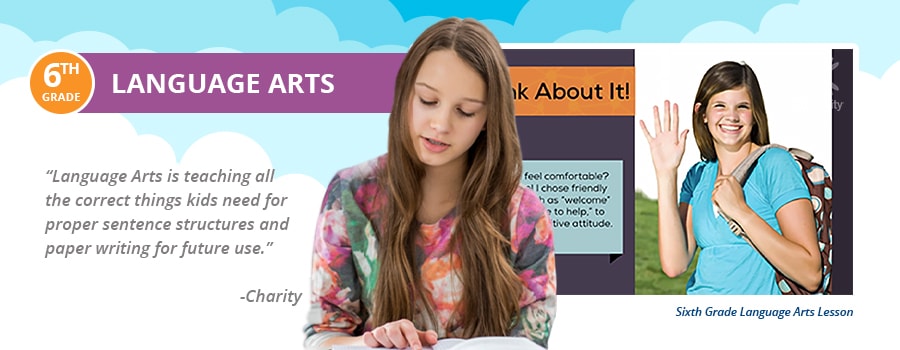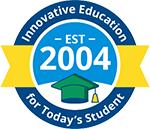Sixth Grade Language Arts Curriculum
Time4Learning’s comprehensive sixth grade language arts curriculum builds off of elementary school foundations by teaching and connecting key skills such as reading, writing, spelling, and grammar.
What English Language Arts (ELA) Skills Should a Sixth Grader Learn?
Our 6th grade curriculum teaches and connects key skills in language arts, that include:
- Reading and summarizing works from different genres (plays, poems, and news articles)
- Applying understanding of grammar, vocabulary, and spelling skills in different types of writing
- Writing a complete paragraph with topic sentence and supporting details
- Conducting research through different sources (books, websites, articles) and summarizing findings
Preview the Time4Learning lesson plans below to see how we integrate these necessary language skills into a comprehensive curriculum.
Reading and Comprehension
Students will read more complex texts across different genres to develop their reading and comprehension skills. Within those texts students will be expected to:
- Use the reading comprehension process skills of summarizing, predicting, visualizing, questioning, and clarifying
- Identify, summarize, or explain the main idea of a text using supporting details
- Compare and contrast characters, settings, ideas, points of view, and/or plots
- Expand vocabulary and use the new terms in reading discussions, reports, and texts
Spelling and Vocabulary
Time4Learning includes spelling activities as part of a well-rounded homeschool curriculum, including spelling lists to study from. Our 6th grade lessons concentrate on:
- Identifying patterns within commonly misspelled words
- Expanding vocabulary to understand longer, multisyllabic words commonly found in grade-level texts
- Using root words, prefixes, and suffixes to build contextual understanding in ELA and other subjects
Grammar and Punctuation
To become good writers, students must know how to apply proper rules for capitalization, punctuation, verb tenses, and all other aspects of grammar. Below are some of the sixth grade learning objectives for grammar.
- Understanding the differences between transitive and intransitive verbs and direct and indirect objects
- Identifying and using descriptive adjectives and adverbs to enhance writing
- Identifying and correctly punctuating dependent and independent clauses
- Using commas in appositives and after introductory words and phrases
- Demonstrating agreement between pronouns and antecedents
Writing and Communication
Sixth grade language arts writing goals are designed to make students more independent writers by teaching them how to effectively use the steps in the writing process (plan, draft, write, revise, edit, publish, and share). Below are some of the sixth grade learning objectives for writing.
- Creating paragraphs and multiple-paragraph essays
- Creating a fictional short story that includes dialogue
- Writing letters for specific situations, including business letters, e-mails, etc.
- Consistently applying rules of spelling
- Demonstrating an expanding vocabulary
Time4Learning 6th Grade Language Arts Lesson Plans
The student will demonstrate knowledge by determining the meaning of synonyms from grade level appropriate vocabulary, by correctly choosing a given word or phrase that means the same thing, in reading activities that incorporate explicit instruction and application.
The student will demonstrate knowledge by determining the meaning of antonyms from grade level appropriate vocabulary, by correctly choosing a given word or phrase that means the opposite, in reading activities that incorporate explicit instruction and application.
The student will be able to analyze and determine the correct meaning of a word, based on the prefix of the root word or how the prefix is used in the context of a passage.
The student will be able to analyze and determine the correct meaning of a word, based on the suffix of the root word or how the suffix is used in the context of a passage.
The student will be able to identify and select the appropriate homophone or word that sounds the same, based on the context of a passage which fits the best meaning of the given word or phrase.
The student will be able to identify and analyze the author’s use of idioms, based on the context of a passage and how these expressions are used in literal and interpretative information.
The student will be able to identify and determine the meaning of unknown words, based on the understanding of Latin and Greek roots.
Use the reading comprehension process skills of summarizing, predicting, visualizing, questioning, and clarifying with extensive scaffolding and support, through think aloud prompts.
Use the reading comprehension process skills of summarizing, predicting, visualizing, questioning, and clarifying with scaffolding and support, through think aloud prompts. with scaffolding and support, through think aloud prompts.
Use the reading comprehension process skills of summarizing, predicting, visualizing, questioning, and clarifying to independently read and comprehend texts with minimal think aloud support.
Develop summaries, paraphrase, or synthesize information from two or more literary or expository texts containing context clues.
Analyze and explain the impact of characters and settings within the plot of literary text(s), and how these relationships affect the central conflict.
Identify, summarize, or explain the main idea(s) using the supporting details in an expository text.
Identify, summarize, or explain the main idea(s) or theme(s) using the supporting details and symbolism in a literary text.
Distinguish between fact and opinion in an expository text or within news sources.
Read, interpret and make predictions using charts, graphs, diagrams, maps or other graphic representations.
Identify and distinguish between cause and effect in expository and literary texts.
Identify and use knowledge of the author’s purpose by analyzing how the literary technique of mood contributes to the comprehension of a literary or expository text.
Use knowledge, information, and ideas from literary texts, expository texts, or from multiple sources to make inferences about the text(s) (e.g., make inferences, draw conclusions, make generalizations, infer sequence of events, and infer a character’s feelings.)
Compare and contrast characters, settings, ideas, point of view, and/or plot within varied genres that includes figurative language such as metaphors.
Students will demonstrate knowledge of comprehension skills on grade level appropriate literary and expository passages, with questions that simulate a high-stakes assessment.
The student will explore content through discovery and develop vocabulary through the use of a literature-based glossary.
The student will achieve comprehension by reading literature with emphasis on vocabulary and respond to the literature. Authentic nonfiction literature is included.
The student will use a variety of strategies to comprehend reading selections. Student uses prior knowledge and will analyze and evaluate to make sense of texts. Student will monitor his or her own comprehension and act purposefully when comprehension breaks down using strategies. Student will write for different purposes and write a variety of compositions based on practical and literary prompts and complete a research-writing project.
Through learning activities focused on recognition and application, the student will practice language art skills. These activities have direct instruction, practice, and scored assessment.
The student will explore content through discovery and develop vocabulary through the use of a literature-based glossary.
The student will achieve comprehension by reading literature with emphasis on vocabulary and respond to the literature. Authentic fiction literature is included.
The student will use a variety of strategies to comprehend reading selections. Student uses prior knowledge and will analyze and evaluate to make sense of texts. Student will monitor his or her own comprehension and act purposefully when comprehension breaks down using strategies. Student will write for different purposes and write a variety of compositions based on practical and literary prompts and complete a research-writing project.
Through learning activities focused on recognition and application, the student will practice language art skills.
The student will explore content through discovery and develop vocabulary through the use of a literature-based glossary.
The student will achieve comprehension by reading literature with emphasis on vocabulary and respond to the literature. Authentic nonfiction literature is included.
The student will use a variety of strategies to comprehend reading selections. Student uses prior knowledge and will analyze and evaluate to make sense of texts. Student will monitor his or her own comprehension and act purposefully when comprehension breaks down using strategies. Student will write for different purposes and write a variety of compositions based on practical and literary prompts and complete a research-writing project.
Through learning activities focused on recognition and application, the student will practice language art skills.
The student will explore content through discovery and develop vocabulary through the use of a literature-based glossary.
The student will achieve comprehension by reading literature with emphasis on vocabulary and respond to the literature. Authentic fiction literature is included.
The student will use a variety of strategies to comprehend reading selections. Student uses prior knowledge and will analyze and evaluate to make sense of texts. Student will monitor his or her own comprehension and act purposefully when comprehension breaks down using strategies. Student will write for different purposes and write a variety of compositions based on practical and literary prompts and complete a research-writing project.
Through learning activities focused on recognition and application, the student will practice language art skills. These activities have direct instruction, practice, and scored assessment.
The student will explore content through discovery and develop vocabulary through the use of a poetry-based glossary.
The student will achieve comprehension by reading poetry with emphasis on vocabulary and respond to the poems.
The student will use a variety of strategies to comprehend reading selections. Student uses prior knowledge and will analyze and evaluate to make sense of texts. Student will monitor his or her own comprehension and act purposefully when comprehension breaks down using strategies. Student will write for different purposes and write a variety of compositions based on practical and literary prompts and complete a research-writing project.
Through learning activities focused on recognition and application, the student will practice language art skills. These activities have direct instruction, practice, and scored assessment.
6th Grade Language Arts Extensions Lesson Plans
Identify interjections, conjunctions, and prepositions in grade-level written composition. Use prepositional phrases to elaborate ideas.
Identify and correctly punctuate dependent and independent clauses.
Use Standard English in grade level appropriate composition. Correctly use the following: “good/well; who/whom between/among; which/that/who.”
Use verb tenses correctly, including present, past, future, and perfect forms, and demonstrate parallel structure (consistent tense) in sentences.
Use commas in dates, city and states, and lists. Use commas in appositives and after introductory words and phrases, as well as with names in direct address.
Capitalize names of organizations, nationalities, races, languages, and religions, as well as titles of books, stories, poems, songs, and articles.
Use quotation marks in dialogue and titles, using grade-level vocabulary.
Correctly identify the main idea and supporting details of an entire text. Paraphrase and summarize text to aid in comprehension.
Demonstrate the use of a variety of reading styles and speed to fit different types of text, including poetry, novels, textbooks, instruction manuals, and newspapers.
Correctly identify an author’s voice or point of view in a written selection, and determine if the selection was written in the first or the third person. Identify monologue and dialogue within a written selection.
Explain how an author’s use of formal or informal language (including the use of slang), as well as denotative and connotative meanings, can help to set the mood or tone of a selection.
Demonstrate understanding of an author’s use of flashbacks and foreshadowing.
Differentiate between an author’s use of literal or figurative language, including imagery, metaphor and simile, symbol, and personification.
Identify common propaganda techniques used in the media. Point out examples of false advertising in television ads for toys, and emotional versus logical arguments found in editorials and opinion pages. Determine whether they contain strong or weak arguments.
Determine the defining characteristics of a speech, and read “Are Women Persons?” by Susan B. Anthony.
Determine the defining characteristics of fiction, including fantasy, mystery, science fiction, realistic fiction, and suspense.
Determine the defining characteristics of an essay, and read “Advice to Youth” by Mark Twain.
Determine the defining characteristics of newspapers. Determine that an author’s purpose is to entertain, inform, or persuade, and relate an author’s purpose to specific details within selected articles of the newspaper. Compare editorials to the use of political cartoons in persuasive journalism. Identify bias.
Determine the defining characteristics of folklore. Compare folklore from the ancient cultures of the Israelites, Muslims, Japanese, and Chinese. Read to compare your culture to the cultures of others.
Explore universal themes in storytelling by comparing several versions of the Cinderella story, pointing out similarities and differences in the versions.
Use the steps of the writing process (plan, draft, write, revise, edit, print, and share) to create a fictional short story that includes dialogue.
Use the steps of the writing process (plan, draft, write, revise, edit, print, and share), and use multimedia to create an autobiographical story (e.g., the day you were born, before you started school, a typical day, your family, your friends, what you most enjoy and what you do best).
Use the steps of the writing process (plan, draft, write, revise, edit, print, and share) to write a poem.
Use the steps of the writing process (plan, draft, write, revise, edit, print, and share) to write letters for various situations, including business letters, e-mail messages, and envelopes.
Use the steps of the writing process (plan—including forming questions for investigation—draft, write, revise, proofread, edit, print, and share) to create a one-act play, correctly using theatrical vocabulary, such as stage, set, act, scene, cast, props, and sound effects.
Understand and correctly use the skills of note making, including the use of graphic organizers such as webbing, clustering, and outlining. Write and present an expository speech or persuasive argument (with supporting evidence), making use of technology to enhance presentation.
Determine the purposes for listening, including to gain information, to solve problems, to enjoy, and to appreciate.
Listen to learn by taking notes, organizing, summarizing, paraphrasing spoken ideas, and asking questions.
Write sequenced, concise, multistep instructions. Follow verbal multistep instructions.
Research and report on careers in the field of language arts, to include journalism, library science, publishing, advertising, and theater (television, movies, video, and video-game creation).







